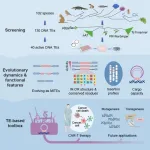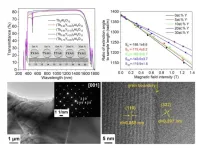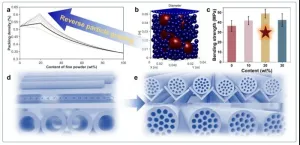(Press-News.org) The human genome contains about 23,000 genes, but only a fraction of those genes are turned on inside a cell at any given time. The complex network of regulatory elements that controls gene expression includes regions of the genome called enhancers, which are often located far from the genes that they regulate.
This distance can make it difficult to map the complex interactions between genes and enhancers. To overcome that, MIT researchers have invented a new technique that allows them to observe the timing of gene and enhancer activation in a cell. When a gene is turned on around the same time as a particular enhancer, it strongly suggests the enhancer is controlling that gene.
Learning more about which enhancers control which genes, in different types of cells, could help researchers identify potential drug targets for genetic disorders. Genomic studies have identified mutations in many non-protein-coding regions that are linked to a variety of diseases. Could these be unknown enhancers?
“When people start using genetic technology to identify regions of chromosomes that have disease information, most of those sites don’t correspond to genes. We suspect they correspond to these enhancers, which can be quite distant from a promoter, so it’s very important to be able to identify these enhancers,” says Phillip Sharp, an MIT Institute Professor Emeritus and member of MIT’s Koch Institute for Integrative Cancer Research.
Sharp is the senior author of the new study, which will appear in Nature. MIT Research Assistant D.B. Jay Mahat is the lead author of the paper.
Hunting for eRNA
Less than 2 percent of the human genome consists of protein-coding genes. The rest of the genome includes many elements that control when and how those genes are expressed. Enhancers, which are thought to turn genes on by coming into physical contact with gene promoter regions through transiently forming a complex, were discovered about 45 years ago.
More recently, in 2010, researchers discovered that these enhancers are transcribed into RNA molecules, known as enhancer RNA or eRNA. Scientists suspect that this transcription occurs when the enhancers are actively interacting with their target genes. This raised the possibility that measuring eRNA transcription levels could help researchers determine when an enhancer is active, as well as which genes it’s targeting.
“That information is extraordinarily important in understanding how development occurs, and in understanding how cancers change their regulatory programs and activate processes that lead to de-differentiation and metastatic growth,” Mahat says.
However, this kind of mapping has proven difficult to perform because eRNA is produced in very small quantities and does not last long in the cell. Additionally, eRNA lacks a modification known as a poly-A tail, which is the “hook” that most techniques use to pull RNA out of a cell.
One way to capture eRNA is to add a nucleotide to cells that halts transcription when incorporated into RNA. These nucleotides also contain a tag called biotin that can be used to fish the RNA out of a cell. However, this current technique only works on large pools of cells and doesn’t give information about individual cells.
While brainstorming ideas for new ways to capture eRNA, Mahat and Sharp considered using click chemistry, a technique that can be used to join two molecules together if they are each tagged with “click handles” that can react together.
The researchers designed nucleotides labeled with one click handle, and once these nucleotides are incorporated into growing eRNA strands, the strands can be fished out with a tag containing the complementary handle. This allowed the researchers to capture eRNA and then purify, amplify, and sequence it. Some RNA is lost at each step, but Mahat estimates that they can successfully pull out about 10 percent of the eRNA from a given cell.
Using this technique, the researchers obtained a snapshot of the enhancers and genes that are being actively transcribed at a given time in a cell.
“You want to be able to determine, in every cell, the activation of transcription from regulatory elements and from their corresponding gene. And this has to be done in a single cell because that’s where you can detect synchrony or asynchrony between regulatory elements and genes,” Mahat says.
Timing of gene expression
Demonstrating their technique in mouse embryonic stem cells, the researchers found that they could calculate approximately when a particular region starts to be transcribed, based on the length of the RNA strand and the speed of the polymerase (the enzyme responsible for transcription) — that is, how far the polymerase transcribes per second. This allowed them to determine which genes and enhancers were being transcribed around the same time.
The researchers used this approach to determine the timing of the expression of cell cycle genes in more detail than has previously been possible. They were also able to confirm several sets of known gene-enhancer pairs and generated a list of about 50,000 possible enhancer-gene pairs that they can now try to verify.
Learning which enhancers control which genes would prove valuable in developing new treatments for diseases with a genetic basis. Last year, the U.S. Food and Drug Administration approved the first gene therapy treatment for sickle cell anemia, which works by interfering with an enhancer that results in activation of a fetal globin gene, reducing the production of sickled blood cells.
The MIT team is now applying this approach to other types of cells, with a focus on autoimmune diseases. Working with researchers at Boston Children’s Hospital, they are exploring immune cell mutations that have been linked to lupus, many of which are found in non-coding regions of the genome.
“It’s not clear which genes are affected by these mutations, so we are beginning to tease apart the genes these putative enhancers might be regulating, and in what cell types these enhancers are active,” Mahat says. “This is a tool for creating gene-to-enhancer maps, which are fundamental in understanding the biology, and also a foundation for understanding disease.”
The findings of this study also offer evidence for a theory that Sharp has recently developed, along with MIT professors Richard Young and Arup Chakraborty, that gene transcription is controlled by membraneless droplets known as condensates. These condensates are made of large clusters of enzymes and RNA, which Sharp suggests may include eRNA produced at enhancer sites.
“We picture that the communication between an enhancer and a promoter is a condensate-type, transient structure, and RNA is part of that. This is an important piece of work in building the understanding of how RNAs from enhancers could be active,” he says.
The research was funded by the National Cancer Institute, the National Institutes of Health, and the Emerald Foundation Postdoctoral Transition Award.
###
Written by Anne Trafton, MIT News
END
New technique reveals how gene transcription is coordinated in cells
By capturing short-lived RNA molecules, scientists can map relationships between genes and the regulatory elements that control them
2024-06-05
ELSE PRESS RELEASES FROM THIS DATE:
Major cause of inflammatory bowel disease discovered
2024-06-05
Researchers at the Francis Crick Institute, working with UCL and Imperial College London, have discovered a new biological pathway that is a principal driver of inflammatory bowel disease (IBD) and related conditions, and which can be targeted using existing drugs.
About 5% of the world’s population, and one in ten people in the UK1, are currently affected by an autoimmune disease, such as IBD, the umbrella term for Crohn’s disease and ulcerative colitis. These diseases are also becoming more common, with over half a million people living with IBD in the UK as of 2022, nearly double the 300,000 previously estimated2.
Despite increasing prevalence, current treatments do not ...
Cooperative proteins help the immune system identify and attack invaders
2024-06-05
LA JOLLA (June 5, 2024)—Bacteria, parasites, viruses—the immune system tackles them all. At the front line of the human immune response are cells called macrophages, which are responsible for correctly identifying intruders and then directing how the entire immune system responds. Researchers at the Salk Institute have now discovered a molecular mechanism that helps macrophages mount a coordinated response tailored to a specific immune challenge.
Activating macrophages requires the work of three versions of a protein complex called SWI/SNF: cBAF, ncBAF, and PBAF. Scientists already knew these variants had slightly different structures, but ...
Why do 1 in 10 Americans get eczema? Is it too much salt?
2024-06-05
Why Do 1 in 10 Americans Get Eczema? Is it Too Much Salt?
UCSF Study finds that changes in daily salt intake may explain eczema flares.
A high sodium diet may increase the risk of eczema, according to researchers at UC San Francisco (UCSF), who found that eating just one extra gram of sodium per day – the amount in a Big Mac – increases the likelihood of flares by 22%.
Eczema, also known as atopic dermatitis, is a chronic disease that causes dry, itchy skin. It’s one of ...
Banning false information traffickers online improved public discourse
2024-06-05
When Twitter banned more than 70,000 traffickers of false information from its platform in the wake of the violence at the U.S. Capitol on Jan. 6, 2021, the impact went beyond the silencing of those users.
A study co-authored by UC Riverside public policy and political science scholars published in the journal Nature on Wednesday, June 5, found that the crackdown by Twitter (now called X after it was acquired by billionaire Elon Musk in late 2022) also significantly reduced the number of misinformation posts by users who stayed on the platform but had been following those who were kicked off.
Additionally, the study found that many of the misinformation ...
Cannabis use common among patients, with most using it to manage a symptom or health condition
2024-06-05
One in six patients in primary care reported cannabis use, with 35% of those using at levels indicating moderate- to high-risk for cannabis use disorder, new UCLA research finds.
The findings, to be published June 5 in JAMA Network Open, suggest that most patients reported using cannabis for symptom management, despite identifying as recreational users, indicating the need for routine cannabis screening. Currently few healthcare systems offer this screening in primary care settings.
“Patients may not tell their primary care providers about their cannabis use, and their doctors ...
Large-scale study reveals functional diversity of DNA transposons and expands genome engineering toolbox
2024-06-05
In a study published in Cell, a research team led by ZHANG Yong'e and WANG Haoyi from the Institute of Zoology of the Chinese Academy of Sciences has characterized the diversity of DNA transposons and expanded the genome engineering toolbox.
"Our systematic and comparative framework complements conventional case studies in elucidating basic biology and strengthening applied biology," said Prof. ZHANG, corresponding author of the study.
Since the first discovery of transposons by Barbara McClintock in the 1940s, scientists ...
Preoperative antibiotic treatment in pediatric elbow fracture surgery is not necessary
2024-06-05
Antibiotic treatment prior to surgical repair of a pediatric elbow fracture does not reduce the risk for post-operative infection, according to new findings from a team of researchers and surgeons from the University of Missouri School of Medicine.
A humerus bone fracture near the elbow is a common injury among children who fall. The typical surgical approach for repairing pediatric elbow fractures is a procedure called closed reduction percutaneous pinning (CRPP). It involves inserting pins or wires through the skin to promote stability and healing of the bone. CRPP is a minimally invasive, safe and effective ...
Experts alert doctors and the public to the arrival of hard-to-treat fungal skin infections in the United States
2024-06-05
Healthcare providers should watch out for new and highly contagious forms of ringworm or jock itch, which are emerging as a potential public health threat, according to a pair of reports.
In the first of the studies, experts at NYU Langone Health who focus on the spread of contagious rashes document the first reported U.S. case of a sexually transmitted fungal infection that can take months to clear up even with treatment. In the second report, NYU Langone physicians partnered with authorities at the New York State ...
Effect of Y substitution on the microstructure, magneto-optical, and thermal properties of (Tb1-xYx)3Al5O12 transparent ceramics
2024-06-05
A team of material scientists led by Jiang Li from Shanghai Institute of Ceramics, Chinese Academy of Sciences, in Shanghai, China recently reported (Tb1-xYx)3Al5O12 magneto-optical ceramics with high optical quality. The optical transmittance, microstructure, Verdet constant, and thermal conductivity of (Tb1-xYx)3Al5O12 with different Y content were investigated in detail. It was found that Y2O3 can suppress the secondary phase and improve the optical quality of TAG ceramics. As optical quality occupies one ...
A reverse particle grading strategy for design and fabrication of porous SiC ceramic supports with improved strength
2024-06-05
Since the brittle characteristics of porous ceramics, high mechanical strength is the most important prerequisite among the fundamental requirements especially when used as the supports. Particle grading strategy has been intensively extended in the preparation of porous ceramics to improve the mechanical strength. Unfortunately, this usually accompanies with the notable sacrifice in porosity. The trade-off between the mechanical strength and porosity is well recognized in the field of porous ceramics, and attempts have been increasingly devoted to overcome the issue.
Recently, a research team ...
LAST 30 PRESS RELEASES:
University of Maryland School of Medicine names distinguished scientist and academic leader Gerald M. Wilson, PhD, as Chair of the Department of Biochemistry and Molecular Biology
Receptors in mammary glands make livestock and humans inviting hosts for avian flu
Icy hot plasmas
Treating adults with autism: Maryland Clinical Center offers national blueprint for care after pediatric transition
University of Phoenix College of Doctoral Studies releases white paper on reclaiming control to build workforce resilience
NCCN Summit seeks to improve care for veterans and first responders with cancer from line-of-duty exposure
ERC Consolidator Grant for soft robotics researcher
Dual-action arts and wellbeing program transforms dementia care
The global plastic waste trade contributes to coastal litter in importing countries, study shows
UT Dallas partners with Tech Mahindra on AI innovation
Blinking less could signal the brain is working harder to listen, Concordia study shows
Male bonobos track females’ reproductive cycle to maximize mating success
New report outlines science priorities for human Mars exploration
Want to curb cannabis-related crashes? Don’t forget older adults, study finds
Expectant management vs medication for patent ductus arteriosus in preterm infants
Pew funds 7 new biomedical research collaborations
The ERC selects 349 mid-career researchers for €728 million in Consolidator Grants
ERC Consolidator Grant awarded to CISPA researcher Rayna Dimitrova
Antimicrobial effects of Syzygium aromaticum and Salvadora persica against common peri-implantitis pathogens in vitro
EVs pose no greater risk to pedestrians than conventional vehicles
Modeling microplastic accumulation under the ocean surface
Pompeii offers insights into ancient Roman building technology
University of Utah engineers give a bionic hand a mind of its own
Transient and long-term risks of common physical activities in people with low back pain
Health care contact days in older adults with metastatic cancer
Brain resilience science reshapes psychiatry from treating illness to building strength
An assessment of the antidepressant potential of deramciclane in two animal tests
Pitt and UPMC study finds epigenetic signature of pediatric traumatic brain injury, paves way for precision recovery tools
Brain discovery opens door to earlier detection of metabolic syndrome in women
SwRI-led study provides insight into oscillations in solar flares
[Press-News.org] New technique reveals how gene transcription is coordinated in cellsBy capturing short-lived RNA molecules, scientists can map relationships between genes and the regulatory elements that control them




